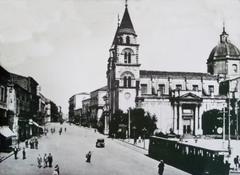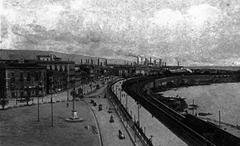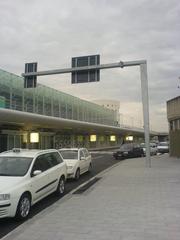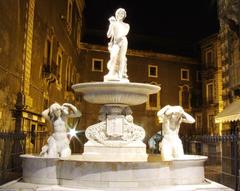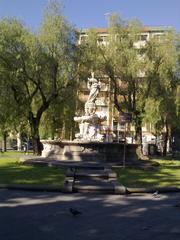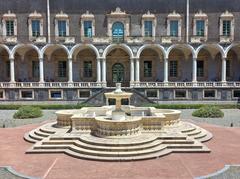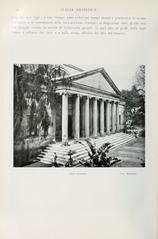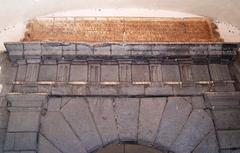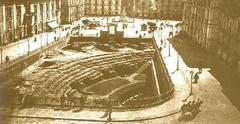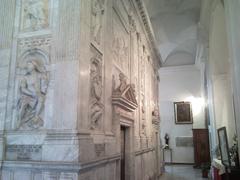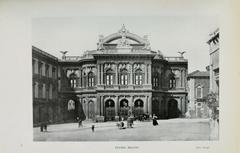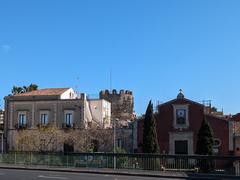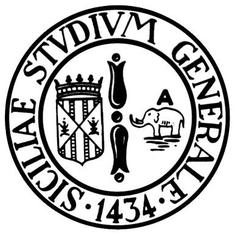
Palazzo degli Elefanti: Visiting Hours, Tickets, and Historical Guide – Catania, Italy
Date: 04/07/2025
Introduction
Nestled in the heart of Catania’s Piazza del Duomo, the Palazzo degli Elefanti is a magnificent symbol of the city’s resilience, civic pride, and Baroque grandeur. Originally rebuilt after the catastrophic 1693 earthquake, this historic city hall encapsulates Catania’s volcanic heritage and serves as a vibrant hub for municipal governance and cultural events. With its iconic elephant motifs, richly decorated interiors, and central role in local traditions, the palace is a must-see destination for anyone exploring Sicily’s artistic and historical treasures.
This comprehensive guide covers the essential aspects of visiting the Palazzo degli Elefanti—from its architectural evolution and cultural significance to practical visitor information, nearby attractions, and insider tips. For current updates and more in-depth details, consult official resources, including the Comune di Catania, Spotting History, and CityMap Sicilia.
Table of Contents
- Introduction
- Historical Overview
- Architectural Features
- The Elephant Symbol & Fountain
- Civic and Cultural Role
- Visiting Information
- What to See Inside
- Nearby Attractions
- Visitor Tips
- FAQs
- Conclusion
- References
Historical Overview
The Palazzo degli Elefanti owes its existence to the reconstruction of Catania after the devastating 1693 earthquake, which leveled much of eastern Sicily (Nomads Travel Guide). Construction began in 1696 under Giovanni Battista Longobardo, with subsequent enhancements by Giovan Battista Vaccarini in the 1730s. The palace’s quadrangular design and strategic location in Piazza del Duomo underscore its civic importance and accessibility.
Throughout its history, the palace has endured further challenges—including wartime damage and fire—but has continually been restored, reflecting Catania’s enduring spirit and adaptability (Spotting History; CityMap Sicilia).
Architectural Features
Palazzo degli Elefanti is a prime example of Sicilian Baroque architecture, with later Neoclassical influences. Highlights include:
- Quadrangular Layout: Entrances on all sides, symbolizing civic openness.
- Main Façade: Central balcony supported by granite columns, used for public addresses.
- Baroque Details: Ornate balconies, carved elephants, and the letter “A” (for Saint Agatha) decorate the facades (CityMap Sicilia).
- Contrast in Materials: Use of local lava stone and white limestone reflects the city’s volcanic heritage.
- Grand Staircase: Designed by Stefano Ittar, the staircase and central courtyard add spatial drama to the interiors (Spotting History).
The Elephant Symbol & Fountain
Directly in front of the palace stands the Fontana dell’Elefante, Catania’s beloved symbol. Designed by Vaccarini in 1736, the fountain features “Liotru,” a black lava stone elephant crowned by an Egyptian obelisk (CityMap Sicilia). The elephant motif recurs throughout the palace’s architecture, embodying Catania’s strength, resilience, and connection to Mount Etna.
Civic and Cultural Role
The palace is the seat of Catania’s City Hall, housing the Mayor’s office, City Council, and Municipal Executive Committee (Comune di Catania). It is central to the city’s governance and public life, hosting ceremonial events, civic receptions, and major festivals.
A highlight is its role during the annual Feast of Saint Agatha, when historic Senate carriages depart from the palace for a traditional procession (Comune di Catania PDF; Visit Catania). The palace also participates in cultural open days, such as the FAI Spring Days (FAI Fondo Ambiente Italiano).
Visiting Information
Visiting Hours
- Monday to Saturday: 9:00 AM – 1:00 PM (some sources note longer hours for administrative functions)
- Sunday & Holidays: Usually closed, except for scheduled tours or events
- Note: Hours may vary due to civic functions or special events. Always check the official website for updates.
Tickets & Admission
- Admission: Free for main public areas and official open days
- Special Exhibitions/Guided Tours: May require advance booking or a nominal fee (Triphobo)
Accessibility
- Wheelchair-accessible entrances and ramps
- Some historic rooms have limited access; contact the tourism office in advance for specific needs (Comune di Catania)
Guided Tours & Events
- Guided Tours: Available in Italian and English; booking recommended, especially during festivals
- Cultural Events: Check the event calendar for exhibitions, concerts, and special open days (FAI)
What to See Inside
- Grand Hall (Aula Magna): Site of official ceremonies, adorned with frescoes and damask walls
- Artworks: Paintings and sculptures by Giuseppe Sciuti, Emilio Greco, and Francesco Contraffatto
- Historic Staircase: A late Baroque masterpiece by Stefano Ittar
- Courtyard: Houses 18th-century Senate carriages, displayed during Saint Agatha’s festivities
Photography is permitted in most public areas, though restrictions may apply during official functions.
Nearby Attractions
Enhance your itinerary with these nearby highlights:
- Catania Cathedral: Next door, featuring the tomb of Vincenzo Bellini
- Elephant Fountain: Iconic city symbol in Piazza del Duomo
- Pescheria Market: Authentic Sicilian fish market just behind the square
- Piazza del Duomo: Lively square with cafes and shops
A combined visit can fill half a day and is especially rewarding during local festivals (The Tourist Checklist).
Visitor Tips
- Best Time: Early morning or late afternoon for fewer crowds
- Dress Code: Modest attire is recommended, especially for adjacent churches
- Language: Most guides speak Italian and English; inquire for additional languages
- Amenities: No café or gift shop inside, but plenty of options in the square
- Safety: The area is generally safe; exercise standard precautions in crowded settings
- Weather: Spring and autumn offer the most pleasant conditions
- Sustainability: Help protect heritage by respecting guidelines and avoiding contact with artworks
Frequently Asked Questions (FAQ)
Q: What are the visiting hours?
A: Monday to Saturday, 9:00 AM – 1:00 PM; check for special event schedules.
Q: Is there an admission fee?
A: Entry is generally free; special tours or exhibitions may require a ticket.
Q: Are guided tours available?
A: Yes, in Italian and English; advance booking is recommended.
Q: Is the palace accessible for visitors with disabilities?
A: Most public areas are accessible; contact the tourism office for details.
Q: Can I take photos inside?
A: Yes, in public areas unless otherwise posted.
Q: What else can I see nearby?
A: Catania Cathedral, Elephant Fountain, Piazza del Duomo, and the Pescheria Market.
Conclusion
The Palazzo degli Elefanti is more than a historic building—it is the living symbol of Catania’s civic pride, artistic legacy, and resilient spirit. Whether you’re captivated by Baroque architecture, intrigued by local traditions, or simply looking to immerse yourself in the energy of Catania’s city center, the palace promises a memorable experience.
For the most up-to-date information, consult the official website. Enhance your visit with the Audiala app for interactive audio tours and tips, and follow us on social media for exclusive updates and event news.
References
- Nomads Travel Guide: Palazzo degli Elefanti
- Spotting History: Palazzo degli Elefanti
- Comune di Catania: Palazzo degli Elefanti
- The Tourist Checklist: Things to Do in Catania
- FAI Fondo Ambiente Italiano: Palazzo degli Elefanti
- CityMap Sicilia: Palazzo degli Elefanti
- Traveling Italian: Catania Travel Guide
- Triphobo: Palazzo degli Elefanti


